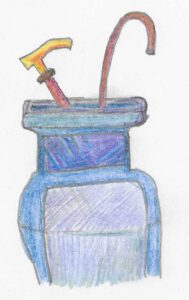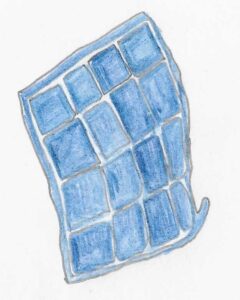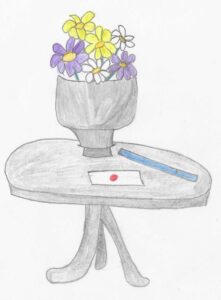Blue Prince came out only in April with a pretty big flash. It seemed like everyone was playing it (and indeed it peaked on Steam with 20,000 players playing at the same time) and everyone was tlaking about i (mentioned acorss mlutiple episodes of The Besties). That peak seems to have died down now, and there feels less of a need to preface every conversation with “no Blue Prince spoilers!” whenever the topic of what we’re playing comes up.
So now seems like an alright time to talk about Blue Prince in a spoiler-lite way, specifically to the people who haven’t yet picked it up.
Like Animal Well, much of te fun of the game comes form the initial diving in and trying to understand what’s going on. Going in blind is the best way to Play Blue Prince, then toiling away at its puzzles by yourself for a while is highly satistfying. Before going any further, if you haven’t played it yet then I suggest you stop reading and go and see if you like it. It will be worth your time. I’ll be talkinga bout some fo the mechanics here which might steal a bit of joy. On the ohter hand, if you’re after a nudge to play it without all the uncertainty (without any strong spoilers) then read on.

The main aim of the game is to reach Room 46, a condition of your inheritance of the manor the game takes place in. I’ll mention this now, and again later, but there’s no time limit on how long you have to secure your inheritance. Go at your own pace.
The game is ostensibly a puzzle game, whose short-story you’re learning from artifacts rather than exposition. You’ll find notes around the house which will make little sense until you connect them with another note or portrait or photograph. If you like ergodic literature like S. (Doug Dorst, a book I never pass on an opportunity to mention) or House of Leaves (Danielewski) then you’ll find this scratching the same itch.
Some of these notes are out in the open and some of them are hidden behind well crafted puzzles. Very much like escape rooms where one immaterial letter from on part of the house suddenly becomes quite important when you realise its true use. This is definitely a note taking game; I made heavy use of Steam’s screenshot feature. The puzzles range from being quite obviously solvable (there is a room with a literal logic puzzle), to rooms where the puzzle seems impenetrable. The delight of the writing in this game is that those impenetrable puzzles will become explain within the game if you’re on the look out for them. Before looking up the answer to a puzzle, I found that focusing elsewhere for a while usually meant its solution is explain to me somewhere in the house.
The core mechanic of the house itself is a mixture of the deck-building of a Slay the Spire style game and the semi-random map building of a Carcassonne. As you enter a room, you’re shown three options for what room could be ahead of you. Each room has a quirk or reward and (most importantly) a varying number of exists to the next room. You’re to place these room tiles in such a way that you don’t block yourself in by closing off your path to get to Room 46. Or, maybe you want to risk blocking off this path because this dead-end room has a few items that will come in handy later.
Like Slay the Spire, it’s hard to know exactly what kind of play through you’ll be doing on a particular day. It depends on the cards you’re dealt. If you’re drawing lots of green cards, you may want to focus on methods of making those more lucrative. The randomness is considered a large fault of the game by many – including me when it felt like I was fighting the RNG to achieve of combination of rooms that never seemed to come up.

It’s not as bad as just rolling a dice though: your deck is largely fixed, with only minor adjustments being made to it throughout the whole game. There are also ways of tilting the TNG in your favour. The “West Hall” for instance only appears in the west of the house. As you play, you’ll want to watch out for patterns like that – there are a number of them. As mentioned earlier, give it enough time and the game will let you into these clues if you don’t manage to solve it yourself. (It will do this quite obviously – so don’t worry you’re missing a clue.)
The game is played in ‘days’, which end when you get blocked in or you run out of ‘Steps’ for the day. At the end of the day, the house resets, ready for you to lay it out again. Only this time you’re hopefully equipped with a little more information or maybe a perminant perk that changes how you’ll play. It’s the iconic “one more turn/day” loop that’s so addicting in Civilisation games. Each day probably won’t run you more than half an hour – unless something is going really well for you on the run.

Like I’ve said already, the game makers will sometimes hint at some time constraint or peril. I described the game to two ergodic books earlier, and those both have some mild peril lingering throughout. This game wanted to have that feeling too. Unfortunately, the feeling doesn’t add to the game at all and from what I’ve seen never actually come to fruition. There’s a particularly spooky thread that doesn’t go anywhere and feels like the writers may have just forgotten to remove it from an earlier version of the game. The game lives in a place of revelled curiosity, and certainly not stress. You can set the controller aside, unpaused, with no impact. You can play for many in-game days and never be locked out of a puzzle or story through line. Play at your own pace. The game is one of the few games I play which works both as a “podcast game” – where full focus isn’t required to continue having fun – and as a “thinking game” where you’ll be taking nots and mulling them over.
I was deeply into this game, and still think every hour was joyfully worth it. I will say that once I got to Room 46 it felt a bit like an end for me, even though the game can continue to be played. I’ve had my fill, for now at least. I’ve heard from many people who are still playing it though, long after they reach the story’s conclusion. There are plenty of puzzles to unlock and keep working on. Justin McElroy said it best: “Play til the end, then one more day, and you’ll know if you will keep playing.”
I think I’ll go back to it eventually – especially if my friends keep excitedly talking about it.
